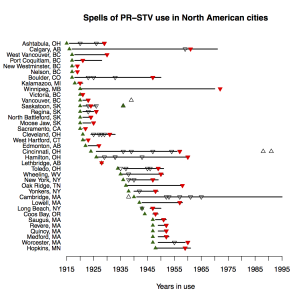I recently did a piece for Sightline on the prospects for proportional representation in British Columbia’s upcoming referendum. The takeaway was that it could pass this time, unlike in 2005 and 2009, because “spoiler voting” by BC Greens is giving the major parties a reason to want to aggregate their votes in multi-seat districts. Calvo (2009) gives the best account of how this works.
This most recent referendum is the product of a deal between the BC New Democratic and BC Green parties. The NDP minority government exists with support from three Green members of the Legislative Assembly. The Liberals are one seat shy of a majority. In the previous two referenda, the third-party vote that brought them about evaporated over the course of the 2000s.
Three things need to happen for this next referendum to pass. Each seems to be in place.
